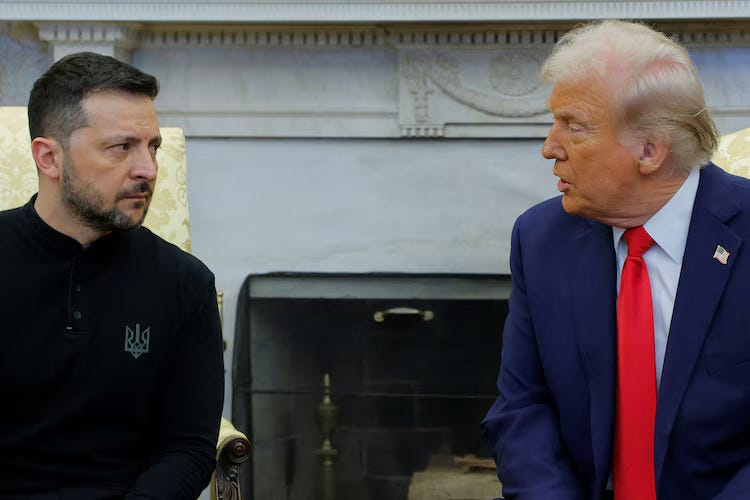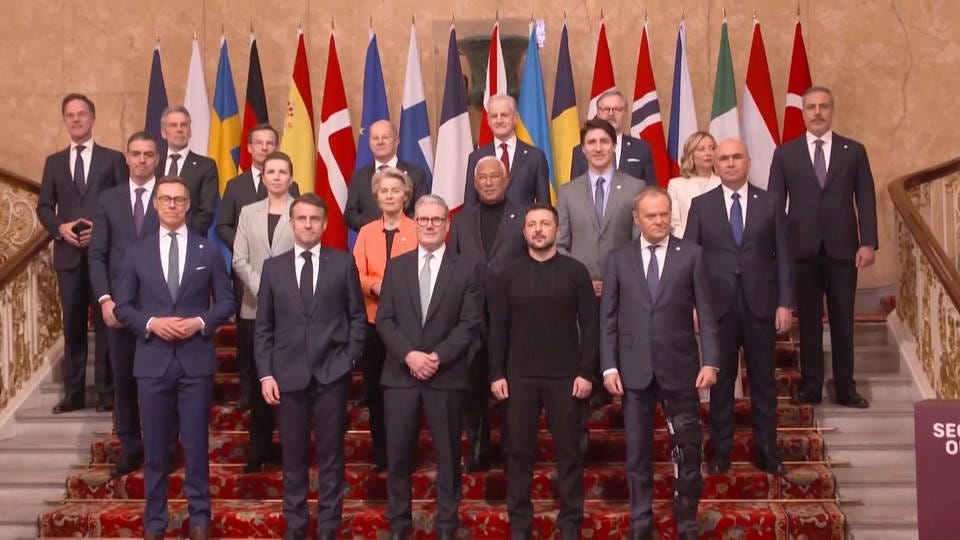Trump-Zelenskyy Meeting Turns Contentious
And The Problems With Televising Diplomatic Negotations.
Introduction
On February 28, 2025, Ukrainian President Volodymyr Zelenskyy met with U.S. President Donald Trump at the White House to finalize a mineral exploration deal for Ukraine. What was expected to be a diplomatic and economic discussion quickly turned into a heated exchange, exposing deep divisions over the future of Ukraine’s war effort, Western support, and U.S. foreign policy. What does this meeting mean for Ukraine’s war effort? How does it reflect shifting global alliances?

In The Beginning…
The meeting began amicably, with Trump praising Ukraine’s military for its resilience and highlighting the necessity of peace talks. Discussions centered around a rare earth mineral exploration deal that could boost Ukraine’s economy while securing critical resources for American industries. Zelenskyy, in turn, showed Trump images from the battlefield and underscored Russian war crimes. His aim was to highlight the necessity of continued Western support for Ukraine.
However, tensions rose when Trump questioned the accountability of American aid to Ukraine. He pointed out that while European assistance was largely provided in the form of loans, American taxpayers had no guarantee of repayment for the billions spent in military and financial aid. This is not entirely true, as only part of the European aid is in the form of loans. It is also true that the USA is significantly richer than most of Europe, barring Norway, which is oil rich, and tax havens like Monaco, Luxembourg, and Lichtenstein.
The Exchange Turns Hostile
Trump encouraged Zelenskyy to engage in direct negotiations with Russian President Vladimir Putin, asserting that Putin had never broken an agreement with him. Zelenskyy, however, implied that Trump underestimated Putin. Since the meeting was televised, Trump may have avoided suggesting he could keep the Kremlin from violating its side of the agreement. The Trump administration supplied Javelins to Ukraine, which directly contradicts the conspiracy theory of him being a Russian puppet. He also expanded American Partnerships with the Baltic Countries, with whom Russia had very cold relations. Russia would have attempted to take over Ukrainian territory in his first term. Vice President JD Vance questioned whether Zelenskyy ever thanked the US for aid, and Trump accused Zelenskyy of gambling with World War 3.
Trump reminded Zelenskyy that while the Obama administration had offered Ukraine only rhetorical support, it was his administration that had provided Javelin missiles and training—key factors in Ukraine’s defense during the Russian invasion. However, Trump also warned that continued American military support was not guaranteed, suggesting that Ukraine needed to seek a diplomatic resolution.
Shortly after, the meeting was cut short, and Zelenskyy was asked to leave the White House. The abrupt conclusion sent shockwaves through diplomatic circles.
Keep Your Friends Close…
Following the meeting, the U.S. announced the withdrawal of key military aid and intelligence-sharing agreements with Ukraine. This development left Ukraine vulnerable, as European military industrial capacity is insufficient to fill the gap left by the United States.
Russia mounted an offensive along the Kursk front, trying to exploit the gap left in Ukraines munitions and intelligence vacuum. Munitions rationing forces Ukraine into a conundrum - does it protect occupied Russian territory, which is a bargaining chip, or does it protect its own territory and people? Doing the former will be quite helpful in negotiations, but Zelesnkyy announced during the White House visit that the war would continue for a long time.
Meanwhile, NATO allies made grandiose statements in support of Ukraine, conveniently ignoring their absolute reliance on U.S. military protection. The reality is stark: without American backing, Europe’s defense capabilities are inadequate to face a direct confrontation with Russia. Hopefully, this is a wake up call for Europe.
The Strategic Implications
The mineral exploration deal was a de facto security guarantee for Ukraine. The U.S. has historically responded quite aggressively to threats against its citizens and interests—such as its entry into World War I after the Lusitania incident, where 128 Americans were killed. Without continued American support, Ukraine’s war effort faces an existential crisis. Intelligence, armaments, ammunition, has largely been supplied to Ukraine by the USA. It will be a while before other suppliers of Ukraine can bridge the gaps.
Europe's Grandstanding Posture and Military Unpreparedness
The incident prompted European leaders and the outgoing Canadian Prime Minister Justin Trudeau to make a grandstanding gesture in solidarity with Zelenskyy in London the following day. The European Union's response, however, underscored a deeper problem: Europe’s military unpreparedness. Despite public posturing, European nations remain critically under-equipped to counter a Russian threat without American support. Germany, for example, lacks even 100 battle-ready tanks, while France has just 70 Caesar howitzers. Britain, too, has only 25 battle-ready tanks. European ammunition and artillery shell production is limited, with much of Ukraine’s artillery shell supply coming from the U.S., India, and South Korea. The influence that EU Member states have is next to zero - Paris cannot even get Algiers to take back its citizens who illegally crossed the Mediterranean Sea.
Moreover, despite their pledges, European nations have failed to provide Ukraine with key military assets. Three years after the initial invasion, the EU has yet to transfer F-16 fighter jets, a move that could have been a game-changer. Similarly, France, despite announcing the retirement of its entire Mirage 2000 fleet, chose not to transfer them to Ukraine. These shortcomings highlight the heavy reliance of Europe on U.S. military support and its limited capability to support Ukraine’s defence. There are very few one-to-one replacements for American Systems that Europe can provide Ukraine. Without American support, it is very difficult for Ukraine to continue fighting. Without American support, Europe’s defence capabilities will be wiped out in short order. European nuclear deterrence does not work either, since France’s nuclear arsenal falls outside NATO’s Command Structure. Similarly, Britain relies on the US for its submarine maintenance, the only platform it has from which it can fire nuclear tipped missiles.
A playground for Conspiracy Theorists
There are several conspiracy theories floating around the internet following the incident. For instance, Some observers b elieve that Zelenskyy is a Russian puppet trying to spark a rift between the EU and the US, trying to ruin Transatlantic Relations. Others propose more elaborate conspiracy theories—that the spat was staged to push the U.S. to align with Russia. This would prompt China to flood Ukraine with Soviet-legacy weaponry to counterbalance Moscow. This, in turn, would deplete China’s munitions stocks, and cut off its access to Russian minerals that were granted after 2022, ultimately crippling both Chinese ambitions. The next American administration would then restore transatlantic ties, having effectively ruined China’s economy and military prowess.
Regardless of whether such theories hold weight, the fallout from the Trump-Zelenskyy meeting has cast uncertainty over Ukraine’s future. With U.S. military support in question, European deficiencies exposed, and an increasingly complex geopolitical chessboard at play, the implications of this diplomatic rupture will reverberate far beyond Kyiv and Washington.
Ceasefire Negotiations
Less than 2 weeks after this fallout, Zelenskyy agreed to enter ceasefire negotiations with Russia, no doubt feeling the brunt of American military and intelligence support, or rather, lack thereof. The Ukrainian Military faced heavy pressure and was forced to withdraw from parts of Kursk, Russian Forces capitalized on the lack of American support for as long as they could, and now the tide of war will stabilize, if not turn.
Conclusion
The Trump-Zelenskyy meeting was more than a failed diplomatic engagement; it was a moment that laid bare the realities of Western military and strategic calculations. Ukraine remains reliant on the West, yet Western nations—particularly in Europe—are not equipped to sustain Ukraine’s war effort independently. Whether this meeting marks the beginning of a new phase in the conflict or simply an episode of high-stakes political drama, one thing is certain: the global balance of power is shifting, and Ukraine is at the center of it. Zelenskyy needs to be careful while navigating this delicate situation as Trump can be a very vindictive man. Ukraine deserves better. It has seen its country invaded, territory occupied, people fleeing, 20000 of its children kidnapped, and now, its means of defending itself. Reliance on the EU is not a realistic option, and American intel and military support is crucial for his military.





Being an enemy of US is Dangerous,
Being its Friend is Fatal - is proved by the recent actions
Trump may be right in preventing participation of war by earlier administrations, but Ukraine (not Zelenskys, whose benefits are another story) is bearing the brunt, with Europe as a silent spectator